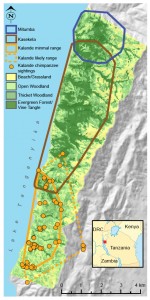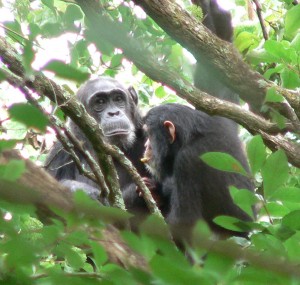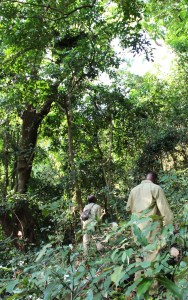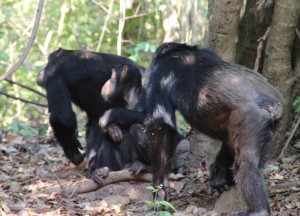In The Better Angels of Our Nature, Steven Pinker argues that violence has declined over the course of human history. This weekend I had the good fortune to participate in a workshop that Pinker organized at Arizona State University on the Origins of Violence.
A number of the speakers were people whose work was central to the argument of Better Angels, which made the workshop feel a bit like stepping into the world of the book. Kind of like that scene in Annie Hall where a guy in line for the movies is holding forth on Marshall McLuhan’s ideas, and Woody Allen produces Marshall McLuhan in person to give his own views.
In addition to talks that elaborated on research described in Better Angels, there were also some pleasant surprises, particularly from a session of talks on why violence seems be declining, not only in frequency, but also in its effectiveness as a strategy.
In Better Angels, Pinker does a superb job of bringing together evolutionary theory, historical data, psychology and political philosophy to summarize and explain an important and under-appreciated finding: violence has decreased at multiple scales over the course of human history and prehistory. Despite claims on the news and by political leaders that the world is a more dangerous place than ever, the data indicate that the world has actually become substantially less dangerous, across the board.
Better Angels is also a big book (832 pages), and a surprisingly common theme of online commentary is “I haven’t finished reading the book, but here is my opinion of it anyway.” For example, here: “I still haven’t finished all of its 800 pages,” and here: “I may as well admit that I haven’t read all of Steven Pinker’s new book.” But it’s a book worth reading all the way through.
Like Pinker’s book, the workshop covered a broad range of scholarship: behavioral ecology, ethnography, neuropsychology, political science, and history. A common theme was shared interests in answering big picture questions with empirical work, strong theoretical foundations, and a willingness to follow the results given by data even when contrary to conventional wisdom. Participants also included speakers invited for the Great Debate, a public event held Saturday evening, among them: evolutionary biologist Richard Dawkins, and one of my favorite science fiction writers, Kim Stanley Robinson.
For the workshop, 14 invited speakers each gave a 15-minute talk, followed by 5 minutes of discussion. Talks covered a wide range of material, but roughly speaking, focused on three main topics: (1) the causes of violence, (2) the decline of violence, and (3) the increasing ineffectiveness of violence. My own work focuses on the causes of violence, and Better Angels exhaustively outlines the evidence for the decline of violence, so I was least familiar with the third group of speakers, whose findings I found particularly novel and interesting.
Causes of Violence
The workshop began on Jane Goodall’s 80th birthday, so I thought it was very appropriate that we began with a discussion of chimpanzees killing each other. That was my talk. Richard Wrangham gave the next talk, in which he discussed violence in chimpanzees and warfare in human hunter-gatherers, drawing attention to some key similarities and differences. In both species, imbalances of power reduce the risks to attackers, making it cost-effective to kill rather than merely chase away enemies. In contrast to intergroup aggression in chimpanzees, human warfare appears to be more dangerous for the attackers, since humans are armed with weapons. This raises questions about what motivates people to undertake those risks. According to Wrangham, the answer is cultural rewards: warriors gain net benefits because their societies reward them for their deeds.
The remaining sessions all focused on humans, starting with a talk by Polly Wiessner, who is an extraordinary ethnographer. She has carried out decades of fieldwork both among the Ju/’hoansi Bushmen in Namibia and the Enga in Papua New Guinea. She compared and contrasted patterns of violence in the two societies. The Bushmen have a strong ethic of nonviolence but nonetheless have a high homicide rate, and few social mechanisms for dealing with the aftermath of violence. The Enga have lots of violence, including frequent warfare, but also have elaborate social mechanisms for negotiation and reconciliation.
Rob Boyd argued that group violence is common in other animals, but only because kinship underlies such violence (as in social insects, and competition between clonal colonies of sea anemones). Boyd argued that humans are unusual because we have lots of group violence among large groups of people who aren’t particularly close kin. In contrast to Wrangham, who focused on the rewards gained by human participants in warfare, Boyd focused on punishment as the mechanism that convinces warriors to risk their lives to benefit other group members. (For more on this, see contrasting papers: Matthew & Boyd (2011) and Glowacki & Wrangham (2013))
Adrian Raine talked about evidence from brain imaging studies about the mechanisms underlying criminal violence. Murderers tend to have low prefrontal cortex activity, indicating that they have trouble inhibiting their impulses towards violence. In contrast, psychopaths (such as serial killers) have strong prefrontal cortex activity, but unusually weak activity in key parts of the amygdala, suggesting that they kill because they have a problem feeling moral emotions. They might know that their actions are wrong; they just don’t feel that they are wrong.
David Courtwright spoke on themes developed in his excellent book Violent Land, which describes the impact of having unbalanced sex ratios in frontier societies. The take-home message: gathering lots of young, unmarried men in one place leads to lots of violence, especially if you add alcohol. Courtwright also talked about two other frontiers: air (early aviation was heavily male-dominated) and night (when city streets become more male-dominated and thus more dangerous).
So to summarize the causes of violence talks: the behavioral strategy of violence has deep roots in biology, but in humans we see an unusual level of group-level violence conducted by people who are not necessarily close kin. This seems to be supported by unusual patterns of grouping (reducing the costs of killing), combined with an unusual system of rewarding warriors and/or punishing cowards to promote participation in warfare. Among individuals, violence is promoted by dysfunction of particular brain regions, and among groups, violence is promoted when large numbers of unmarried men are gathered together. Societies may vary greatly in how they handle violence, but people everywhere face both the risk of violence, and the question of how to prevent violence.
Decline of Violence
The central argument of Pinker’s Better Angels of Our Nature is that warfare and other forms of violence have declined over time. Pinker based his argument on extensive work by a number of other scholars, including several of the speakers invited to the workshop.
One of the key people who has assembled data on the high rates of violence in non-state societies is Azar Gat, author of War in Human Civilization. At the workshop, Gat talked about the ongoing debate between Hobbeseans and Rousseauites over the origins of warfare. Hobbeseans follow political philosopher Thomas Hobbes in arguing that the ancestral condition of humanity was war of all against all. Rousseauites follow Jean-Jacques Rousseau in arguing that the state of nature was a peaceful world of noble savages. Gat argued that while this debate might seem unresolvable, in recent years Rousseauites have shifted their positions, effectively conceding that the evidence indicates humans have a long history and prehistory of some forms of violence, including homicide and feuding, even if Rousseauites continue to disagree about the evidence for early war. Gat also argued that, in contrast to the Rousseauite anxiety that arguing for evidence of a warlike past promotes a warlike future, the existence of prehistoric warfare is no impediment to building a more peaceful future.
Another key person documenting the decline of violence is Manuel Eisner, who has conducted meticulous studies of European historical records, leading to the discovery of a striking decline in homicide rates in Europe over the past 600 years. He presented new data both on overall homicide rates, and on regicide (take home message: it’s dangerous to be king!).
The workshop also included two people who have documented the recent decline in warfare: John Mueller and Joshua Goldstein. Based on studies of the number of ongoing wars per year, Mueller has concluded that “war has almost ceased to exist.” Great powers no longer engage in direct warfare with each other, and even minor powers seem increasingly reluctant to fight wars. Goldstein has argued that, despite the US being involved in wars in Iraq and Afghanistan, “the decade since 9/11 has been the most peaceful worldwide in the past century.”
Christopher Fettweis presented detailed work on mortality from warfare over the years in Africa. Back in 1994, Robert Kaplan predicted “The Coming Anarchy,” in which West Africa in particular would be overwhelmed by rapidly growing populations, chaos and warfare. In contrast, what the actual data show is that over the ensuing decades Africa has become increasingly peaceful. Fettweis argued that Africa likely now enjoys a lower risk of death from warfare than ever before. Today, the average person living in Africa is less likely to die from war than the average American is to die from homicide.
So despite claims from political leaders that the world is “more dangerous than it has ever been,” the risk of dying from violence, including homicide and war, actually has decreased considerably across history and (as far as we can tell) prehistory.
Ineffectiveness of Violence
There are many possible reasons for the decline of violence. One important reason may be the growing recognition that violence is a decreasingly effective way to accomplish goals.
Max Abrahms argued that based on empirical data, terrorism usually fails to accomplish the goals of terrorists. In particular, killing civilians – the most feared practice of terrorists – is usually self-defeating: groups that kill civilians are more likely to fail in attaining their goals. So why do terrorists ever do this? Abrahms argued that it is mainly the lower-ranking members of organizations with weak leadership that carry out such attacks. Attacking “hard” targets like military bases is, well, hard. It’s easier to attack “soft” targets like cafes and buses, so that’s what low-level terrorists do, especially when their more experienced bosses don’t have sufficient control to stop them. In contrast, the more experienced, higher-level terrorists gradually learn that killing civilians is counter-productive and focus instead on different goals. Based on this finding, the current US strategy of using drones to “decapitate” Al Qaeda by killing leaders is likely increasing, rather than reducing, the likelihood of attacks on civilians by this organization.
Continuing on the topic of terrorists, Adam Lankford took a critical view of suicide terrorism, in the context of self-sacrificial behavior in general. Lankford argued that intentionally self-sacrificial behavior is rare: mother mammals rarely give up their lives to save their young (their fitness benefits more if they live to breed another day), and soldiers don’t fall on grenades. Soldiers do sometimes move towards grenades to throw them back at the enemy, or attempt to smother them with a backpack, helmet or boot, but they don’t lie down on a grenade and wait for it to explode into their bodies. Lankford further argued that many suicide terrorists are really just suicidal. Moreover, Lankford argued that suicide terrorism isn’t terribly effective, that it fails in about half the cases, and even when successful rarely kills many people. Lankford’s results, combined with Abrahms’s arguments that terrorism against civilians is counter-productive, suggest that terrorism is just a really bad strategy.
Instead, based on Erika Chenoweth’s findings, people seeking political change would be better off doing so nonviolently. With a meticulous, skeptically motivated empirical study, Chenoweth found that nonviolent campaigns are about twice as effective as violent rebellions in accomplishing their aims, such as removing leaders and winning territorial independence. Since the end of World War II, nonviolent campaigns have also become more common as a strategy. And unlike violent rebellion, they don’t benefit much from foreign intervention – they need to be home-grown to work effectively. The key seems to be getting a sufficiently large proportion of the society involved: groups with at least 3.5% of the population participating always achieved their aims. Additionally, the methods used to gain power have important impacts on how groups govern if they are successful. Nonviolent groups are more democratic and respect human rights more so than groups that gained power through violent means.
None of this means that we live in a world without danger of warfare and other kinds of violence. The recent events in Ukraine make that clear. Nonetheless, those very events help illustrate some key points. First, the nonviolent protests against Ukraine’s government succeeded in removing an unpopular leader. Second, the subsequent invasion of Crimea by Russia resulted in only two casualties and an election. While the invasion clearly carried the menace of violence, and the election was certainly far from fair, both were a far cry from what would have happened in previous decades.
Given the rhetoric of pundits and political leaders that we live in a dangerous world, it is important to realize that, compared to almost all of recorded history, the world today is remarkably peaceful. Moreover, in today’s world, peaceful methods are frequently more effective than violent ones.
Interested in learning more about what these speakers have to say? Check out the Origins of Violence Reading List!
References
Glowacki, L. and R. W. Wrangham (2013). “The Role of Rewards in Motivating Participation in Simple Warfare.” Human Nature-an Interdisciplinary Biosocial Perspective 24(4): 444-460.
Mathew, S. and R. Boyd (2011). “Punishment sustains large-scale cooperation in prestate warfare.” Proceedings of the National Academy of Sciences of the United States of America 108(28): 11375-11380.
Pinker, S. (2011). The Better Angels of Our Nature: Why Violence Has Declined, Viking.

















